关于 vivo Pad 5 Pro 的结论
在功能相当的情况下,vivo Pad 5 Pro 的进口价格仅为 iPad Air 13 的一半多,在中国甚至要便宜得多。
尽管如此,我们的测试设备并没有什么可隐瞒的:首先,它的运行时间明显更长,外壳更轻更薄。此外,它还具有坚固、时尚、快速的 WLAN 上网功能和色彩还原良好的明亮屏幕。
在性能方面,vivo Pad 5 Pro 做了一些妥协,但只有在执行要求极高的任务时才会明显感觉到。
得益于极少的热量积聚、良好的扬声器和支持多种语言的简洁系统软件,它是 iPad Air 当之无愧的、价格合理的竞争对手。
唯一的缺点是需要从中国进口设备--通过我们的租赁合作伙伴深圳贸易公司,这一过程变得更加容易--以及软件支持的不确定性。
Pros
Cons
价格和供应情况
在我们的租赁商tradingshenzhen.com,配备 16GB 内存和 512GB 大容量存储空间的版本仅售700 多欧元。
不过,配备 8GB 内存和 256GB 大容量存储空间的平板电脑售价也低于 570 欧元。
该平板电脑的全球上市时间尚未确定。
规格
外壳和功能 - vivo Pad 5 Pro 的坚固金属外壳
这款平板电脑配有一个高品质的金属外壳,有玫瑰红、浅蓝和灰色三种颜色可供选择。尽管尺寸不大,但却相对坚固,只有边角在受压时会出现轻微弯曲。
它的重量为 578 克,相当轻巧,厚度为 5.9 毫米,比Apple 的 iPad Air 13 略薄。 iPad Air 13.
我们的机型包括 16 GB 内存和 512 GB 大容量存储空间;也有 256 GB 存储空间和 8 或 12 GB 内存的机型可供选择。不过,vivo Pad 5 Pro 不支持移动网络或卫星定位。
» Notebookcheck多媒体笔记本电脑Top 10排名
» Notebookcheck游戏笔记本电脑Top 10排名
» Notebookcheck低价办公/商务笔记本电脑Top 10排名
» Notebookcheck高端办公/商务笔记本电脑Top 10排名
» Notebookcheck工作站笔记本电脑Top 10排名
» Notebookcheck亚笔记本电脑Top 10排名
» Notebookcheck超级本产品Top 10排名
» Notebookcheck变形本产品Top 10排名
» Notebookcheck平板电脑Top 10排名
» Notebookcheck智能手机Top 10排名
» Notebookcheck评测过最出色的笔记本电脑屏幕
» Notebookcheck售价500欧元以下笔记本电脑Top 10排名
» Notebookcheck售价300欧元以下笔记本电脑Top 10排名
通信和操作 - 快速上网的 WiFi 6
您必须使用 Wi-Fi 6,因此我们的中国机型无法使用很少使用的 6 GHz 频段。不过,它的速度与同类产品相当,只是在上传时稍慢一些。
触摸屏反应灵敏,如果需要,还可以使用手写笔。键盘盖是可选配件。
没有指纹传感器,但支持面部识别。虽然它只使用二维识别,安全性较低,但运行可靠。
| Networking | |
| Vivo Pad 5 Pro | |
| iperf3 transmit AXE11000 | |
| iperf3 receive AXE11000 | |
| Oppo Pad 4 Pro | |
| iperf3 transmit AXE11000 | |
| iperf3 receive AXE11000 | |
| Samsung Galaxy Tab S10 FE+ | |
| iperf3 transmit AXE11000 | |
| iperf3 receive AXE11000 | |
| Huawei MatePad Pro 13.2 (2025) | |
| iperf3 transmit AXE11000 | |
| iperf3 receive AXE11000 | |
| Apple iPad Air 13 2025 | |
| iperf3 transmit AXE11000 6GHz | |
| iperf3 receive AXE11000 6GHz | |
| Average 802.11 a/b/g/n/ac/ax | |
| iperf3 transmit AXE11000 | |
| iperf3 receive AXE11000 | |
| iperf3 transmit AXE11000 6GHz | |
| iperf3 receive AXE11000 6GHz | |
| Average of class Tablet | |
| iperf3 transmit AXE11000 | |
| iperf3 receive AXE11000 | |
| iperf3 transmit AXE11000 6GHz | |
| iperf3 receive AXE11000 6GHz | |
软件和可持续性 - 专为多任务处理而设计
OriginOS 5 HD 是基于Android 15 的操作系统名称。它允许应用程序在窗口或分屏模式下运行,还包括其他一些支持平板电脑生产性使用的功能。
在测试时,安全补丁是从 2025 年 3 月开始的,有些过时。关于未来软件更新的持续时间,也没有明确的信息。通过深圳贸易公司购买的平板电脑有一年保修期,可通过德国退货地址进行维修。
这款平板电脑在可持续发展方面没有做出明显的努力,甚至平板电脑周围的保护膜也是用塑料制成的。
摄像头 - 对于平板电脑来说质量非常高
Image comparison
Choose a scene and navigate within the first image. One click changes the position on touchscreens. One click on the zoomed-in image opens the original in a new window. The first image shows the scaled photograph of the test device.
Main camera PlantMain camera NeighborhoodMain camera Low Light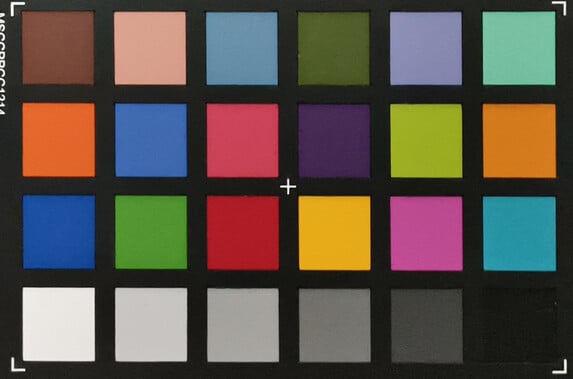

显示屏 - 明亮且无 PWM
| |||||||||||||||||||||||||
Brightness Distribution: 94 %
Center on Battery: 683 cd/m²
Contrast: 1366:1 (Black: 0.5 cd/m²)
ΔE ColorChecker Calman: 1.9 | ∀{0.5-29.43 Ø4.78}
ΔE Greyscale Calman: 2.4 | ∀{0.09-98 Ø5}
99.5% sRGB (Calman 2D)
Gamma: 2.378
CCT: 6867 K
| Vivo Pad 5 Pro IPS, 3096x2064, 13" | Oppo Pad 4 Pro LTPS LCD, 3392x2400, 13.2" | Samsung Galaxy Tab S10 FE+ TFT-LCD, 2880x1800, 13.1" | Huawei MatePad Pro 13.2 (2025) Flexible OLED, 2880x1920, 13.2" | Apple iPad Air 13 2025 IPS, 2732x2048, 12.9" | |
|---|---|---|---|---|---|
| Screen | -11% | 1% | 20% | -2% | |
| Brightness middle (cd/m²) | 683 | 672 -2% | 779 14% | 795 16% | 607 -11% |
| Brightness (cd/m²) | 668 | 652 -2% | 751 12% | 791 18% | 576 -14% |
| Brightness Distribution (%) | 94 | 93 -1% | 90 -4% | 97 3% | 87 -7% |
| Black Level * (cd/m²) | 0.5 | 0.46 8% | 0.43 14% | 0.5 -0% | |
| Contrast (:1) | 1366 | 1461 7% | 1812 33% | 1214 -11% | |
| Colorchecker dE 2000 * | 1.9 | 3.18 -67% | 1.9 -0% | 1.1 42% | 1.52 20% |
| Colorchecker dE 2000 max. * | 3.42 | 4.84 -42% | 5 -46% | 2.5 27% | 3.5 -2% |
| Greyscale dE 2000 * | 2.4 | 2.2 8% | 2.7 -13% | 2.1 12% | 2.2 8% |
| Gamma | 2.378 93% | 2.396 92% | 2.2 100% | 2.23 99% | 2.197 100% |
| CCT | 6867 95% | 7070 92% | 6923 94% | 6822 95% | 6929 94% |
* ... smaller is better
Screen Flickering / PWM (Pulse-Width Modulation)
| Screen flickering / PWM not detected | |||
In comparison: 53 % of all tested devices do not use PWM to dim the display. If PWM was detected, an average of 8091 (minimum: 5 - maximum: 343500) Hz was measured. | |||
Display Response Times
| ↔ Response Time Black to White | ||
|---|---|---|
| 62.3 ms ... rise ↗ and fall ↘ combined | ↗ 11.2 ms rise | |
| ↘ 15.1 ms fall | ||
| The screen shows slow response rates in our tests and will be unsatisfactory for gamers. In comparison, all tested devices range from 0.1 (minimum) to 240 (maximum) ms. » 100 % of all devices are better. This means that the measured response time is worse than the average of all tested devices (20.2 ms). | ||
| ↔ Response Time 50% Grey to 80% Grey | ||
| 33.7 ms ... rise ↗ and fall ↘ combined | ↗ 17.5 ms rise | |
| ↘ 16.2 ms fall | ||
| The screen shows slow response rates in our tests and will be unsatisfactory for gamers. In comparison, all tested devices range from 0.165 (minimum) to 636 (maximum) ms. » 45 % of all devices are better. This means that the measured response time is similar to the average of all tested devices (31.6 ms). | ||
性能、排放和电池寿命--动力充沛
联发科 Dimensity 9400是一款高端 SoC,通常性能强劲。然而,vivo Pad 5 Pro 无法与 Oppo Pad 4 Pro的 骁龙 8 精英版或Apple iPad Air 13.
基准测试结果清楚地反映了两者的差异。尽管如此,除非您使用该平板电脑执行高要求的任务,否则性能差距不太可能明显。在我们的日常使用测试中,vivo Pad 5 Pro 在处理多任务时没有出现任何问题。
发热量极小,主要集中在顶部中心位置,这可能是 SoC 的位置。不过,3DMark 压力测试显示,在长时间负载情况下性能会明显下降。
该系统共包括 8 个扬声器(4 个高音扬声器和 4 个低音扬声器),整体音质良好。但有时清晰度有待提高,而且最大音量略有限制,不过对于一个中等大小的房间来说已经足够。无线音频支持多种蓝牙音频编解码器。
由于配备了 12010 mAh 电池,vivo Pad 5 Pro 的续航时间非常出色,在我们的 WLAN 测试中,续航时间接近 19 小时。这可以轻松覆盖整个工作日或长时间休闲使用。该平板电脑支持高达 66 瓦的快速充电,可在 2 小时内充满电。
| Geekbench AI | |
| Single Precision NPU 1.5 | |
| Vivo Pad 5 Pro | |
| Average Mediatek Dimensity 9400 (n=1) | |
| Average of class Tablet (166 - 5295, n=28, last 2 years) | |
| Half Precision NPU 1.5 | |
| Vivo Pad 5 Pro | |
| Average Mediatek Dimensity 9400 (n=1) | |
| Average of class Tablet (154 - 41155, n=28, last 2 years) | |
| Quantized NPU 1.5 | |
| Vivo Pad 5 Pro | |
| Average Mediatek Dimensity 9400 (n=1) | |
| Average of class Tablet (88 - 57388, n=28, last 2 years) | |
| Vivo Pad 5 Pro | Oppo Pad 4 Pro | Samsung Galaxy Tab S10 FE+ | Huawei MatePad Pro 13.2 (2025) | Average 512 GB UFS 4.1 Flash | Average of class Tablet | |
|---|---|---|---|---|---|---|
| AndroBench 3-5 | -10% | -53% | -27% | 0% | -45% | |
| Sequential Read 256KB (MB/s) | 4088.5 | 3801.54 -7% | 1686.77 -59% | 1864.54 -54% | 3734 ? -9% | 1786 ? -56% |
| Sequential Write 256KB (MB/s) | 3095.4 | 3334.62 8% | 999.78 -68% | 1441.8 -53% | 3209 ? 4% | 1337 ? -57% |
| Random Read 4KB (MB/s) | 295.8 | 297.28 1% | 228.91 -23% | 305.89 3% | 380 ? 28% | 246 ? -17% |
| Random Write 4KB (MB/s) | 562.5 | 335.89 -40% | 211.53 -62% | 533.47 -5% | 438 ? -22% | 279 ? -50% |
(±) The maximum temperature on the upper side is 44 °C / 111 F, compared to the average of 33.6 °C / 92 F, ranging from 20.7 to 53.2 °C for the class Tablet.
(±) The bottom heats up to a maximum of 44.7 °C / 112 F, compared to the average of 33.2 °C / 92 F
(+) In idle usage, the average temperature for the upper side is 26.7 °C / 80 F, compared to the device average of 30 °C / 86 F.
3DMark Steel Nomad Stress Test
| 3DMark | |
| Wild Life Stress Test Stability | |
| Huawei MatePad Pro 13.2 (2025) | |
| Samsung Galaxy Tab S10 FE+ | |
| Vivo Pad 5 Pro | |
| Oppo Pad 4 Pro | |
| Wild Life Extreme Stress Test | |
| Huawei MatePad Pro 13.2 (2025) | |
| Samsung Galaxy Tab S10 FE+ | |
| Apple iPad Air 13 2025 | |
| Oppo Pad 4 Pro | |
| Vivo Pad 5 Pro | |
| Solar Bay Stress Test Stability | |
| Apple iPad Air 13 2025 | |
| Vivo Pad 5 Pro | |
| Oppo Pad 4 Pro | |
| Steel Nomad Light Stress Test Stability | |
| Huawei MatePad Pro 13.2 (2025) | |
| Apple iPad Air 13 2025 | |
| Oppo Pad 4 Pro | |
| Vivo Pad 5 Pro | |
Vivo Pad 5 Pro audio analysis
(+) | speakers can play relatively loud (83.8 dB)
Bass 100 - 315 Hz
(±) | reduced bass - on average 7.7% lower than median
(±) | linearity of bass is average (13.4% delta to prev. frequency)
Mids 400 - 2000 Hz
(±) | higher mids - on average 5.3% higher than median
(+) | mids are linear (3.4% delta to prev. frequency)
Highs 2 - 16 kHz
(+) | balanced highs - only 3.1% away from median
(+) | highs are linear (6.5% delta to prev. frequency)
Overall 100 - 16.000 Hz
(+) | overall sound is linear (10.4% difference to median)
Compared to same class
» 8% of all tested devices in this class were better, 3% similar, 89% worse
» The best had a delta of 7%, average was 20%, worst was 129%
Compared to all devices tested
» 5% of all tested devices were better, 1% similar, 94% worse
» The best had a delta of 4%, average was 24%, worst was 134%
Huawei MatePad Pro 13.2 (2025) audio analysis
(+) | speakers can play relatively loud (88.4 dB)
Bass 100 - 315 Hz
(±) | reduced bass - on average 9.2% lower than median
(±) | linearity of bass is average (7.1% delta to prev. frequency)
Mids 400 - 2000 Hz
(+) | balanced mids - only 4.2% away from median
(+) | mids are linear (5.1% delta to prev. frequency)
Highs 2 - 16 kHz
(+) | balanced highs - only 1.5% away from median
(+) | highs are linear (2.2% delta to prev. frequency)
Overall 100 - 16.000 Hz
(+) | overall sound is linear (8.9% difference to median)
Compared to same class
» 2% of all tested devices in this class were better, 2% similar, 96% worse
» The best had a delta of 7%, average was 20%, worst was 129%
Compared to all devices tested
» 2% of all tested devices were better, 1% similar, 97% worse
» The best had a delta of 4%, average was 24%, worst was 134%
| Vivo Pad 5 Pro 12010 mAh | Oppo Pad 4 Pro 12140 mAh | Samsung Galaxy Tab S10 FE+ 10090 mAh | Huawei MatePad Pro 13.2 (2025) 5050 mAh | Apple iPad Air 13 2025 mAh | |
|---|---|---|---|---|---|
| Battery runtime | -5% | -1% | -52% | -31% | |
| WiFi v1.3 (h) | 19 | 18 -5% | 18.9 -1% | 9.2 -52% | 13.2 -31% |
| Reader / Idle (h) | 43.2 | 25.5 | |||
| H.264 (h) | 21.5 | 13.8 | |||
| Load (h) | 4.9 | 5 |
Notebookcheck 总体评分
Vivo Pad 5 Pro
- 07/06/2025 v8
Florian Schmitt
可能的替代品比较
Transparency
The selection of devices to be reviewed is made by our editorial team. The test sample was provided to the author as a loan by the manufacturer or retailer for the purpose of this review. The lender had no influence on this review, nor did the manufacturer receive a copy of this review before publication. There was no obligation to publish this review. As an independent media company, Notebookcheck is not subjected to the authority of manufacturers, retailers or publishers.
This is how Notebookcheck is testing
Every year, Notebookcheck independently reviews hundreds of laptops and smartphones using standardized procedures to ensure that all results are comparable. We have continuously developed our test methods for around 20 years and set industry standards in the process. In our test labs, high-quality measuring equipment is utilized by experienced technicians and editors. These tests involve a multi-stage validation process. Our complex rating system is based on hundreds of well-founded measurements and benchmarks, which maintains objectivity. Further information on our test methods can be found here.






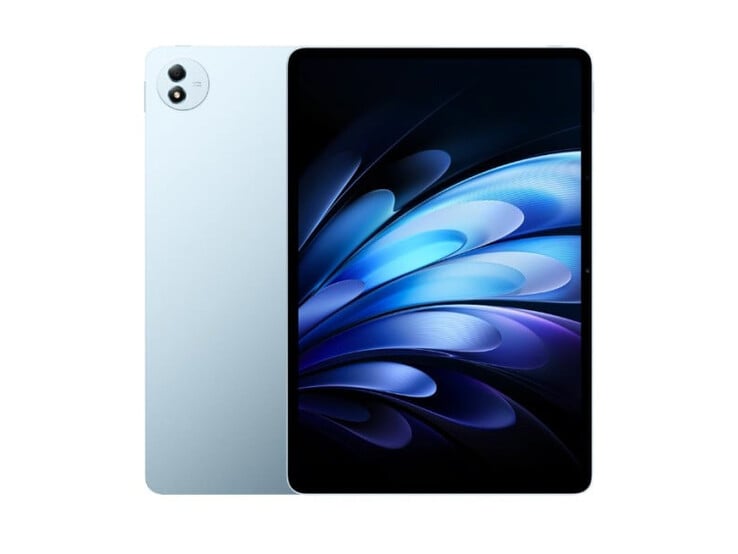
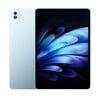
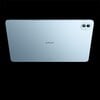


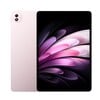


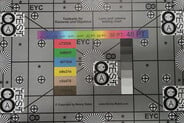



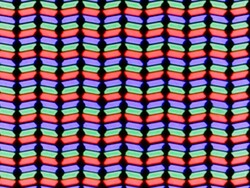
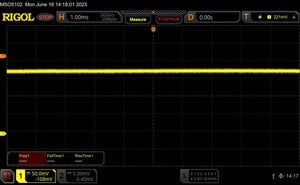

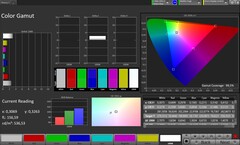
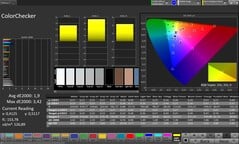


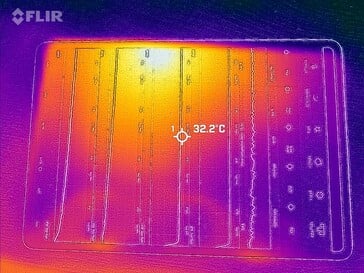
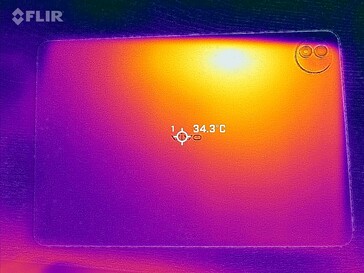

 Total Sustainability Score:
Total Sustainability Score: 